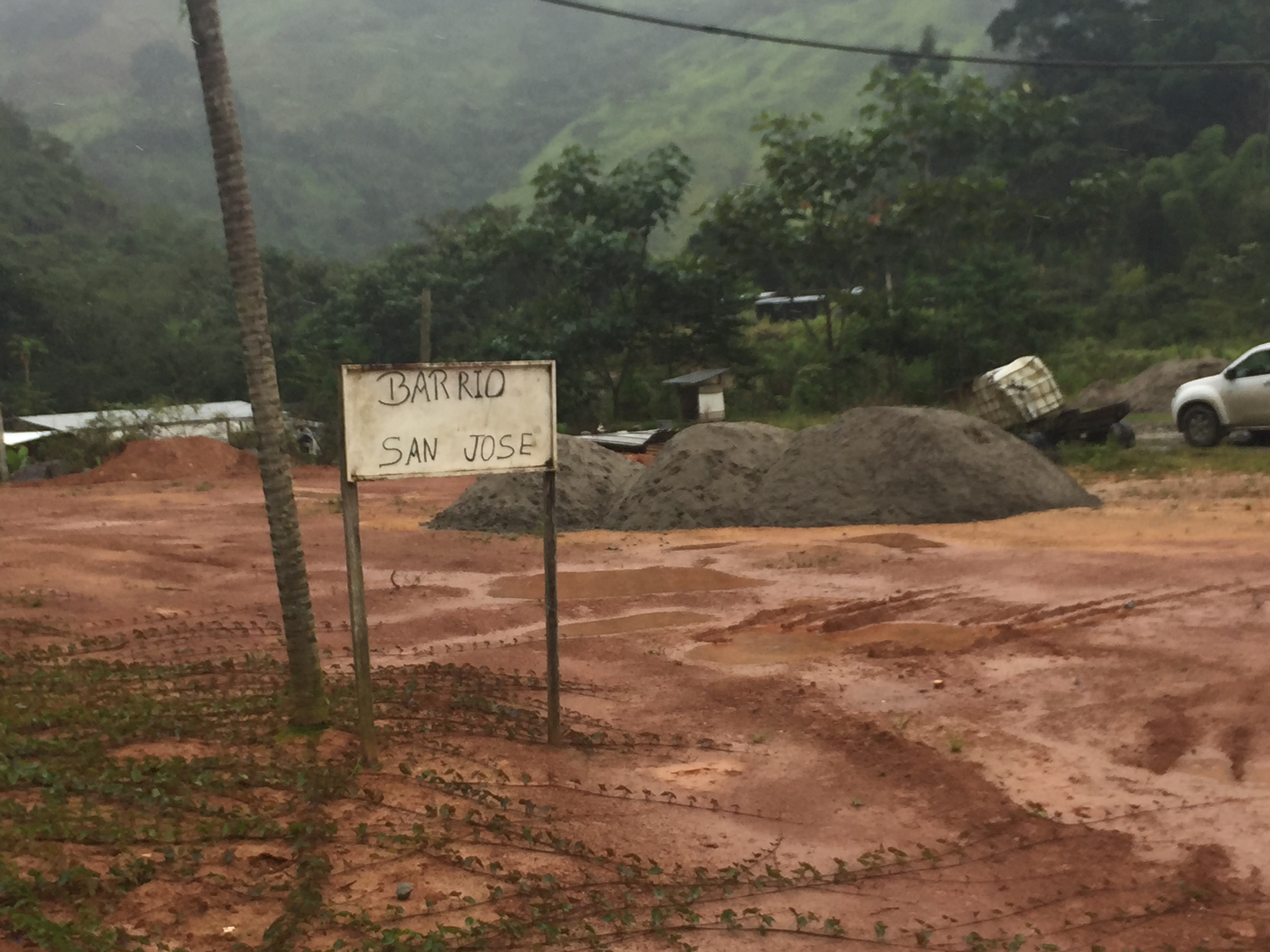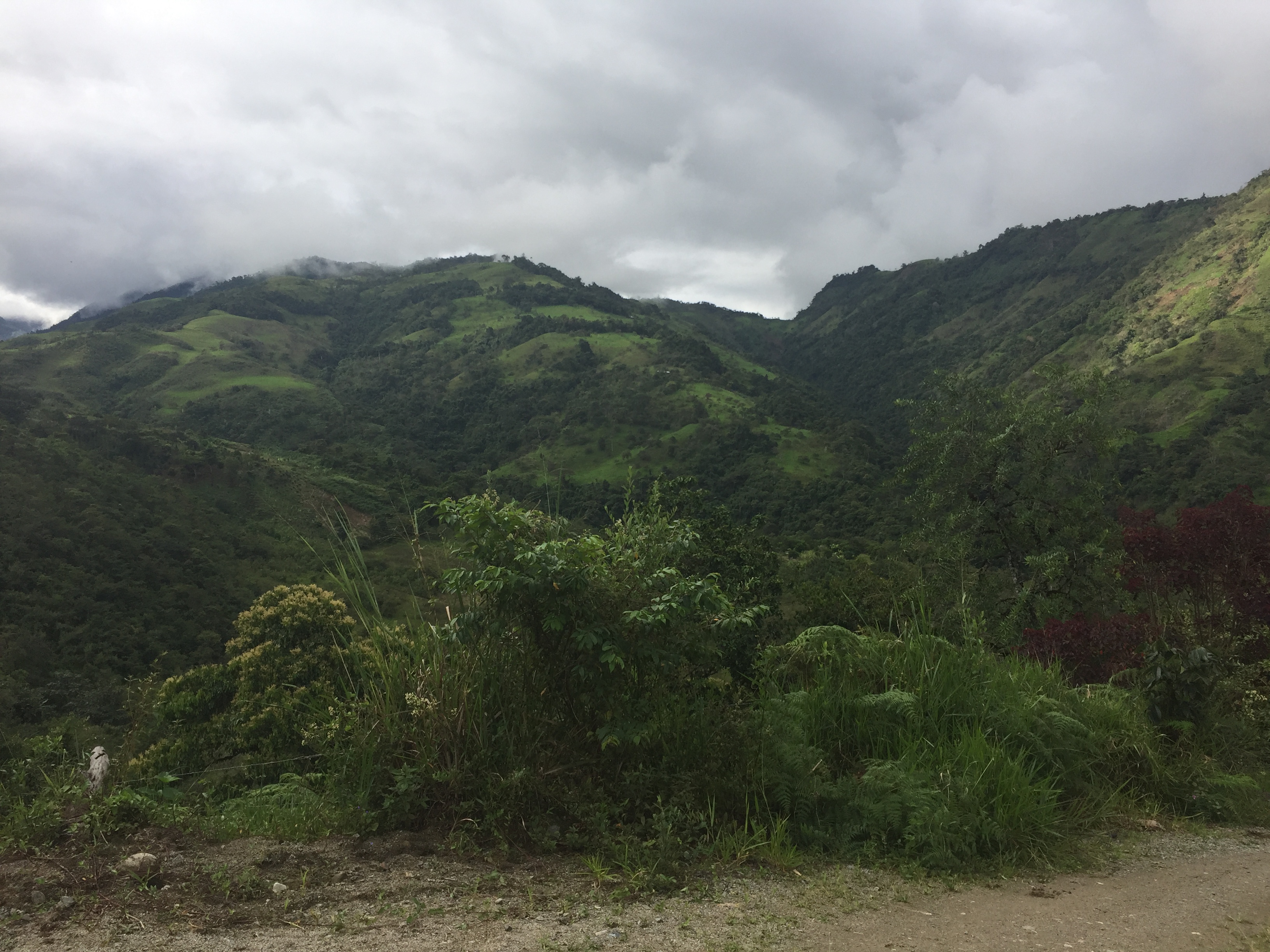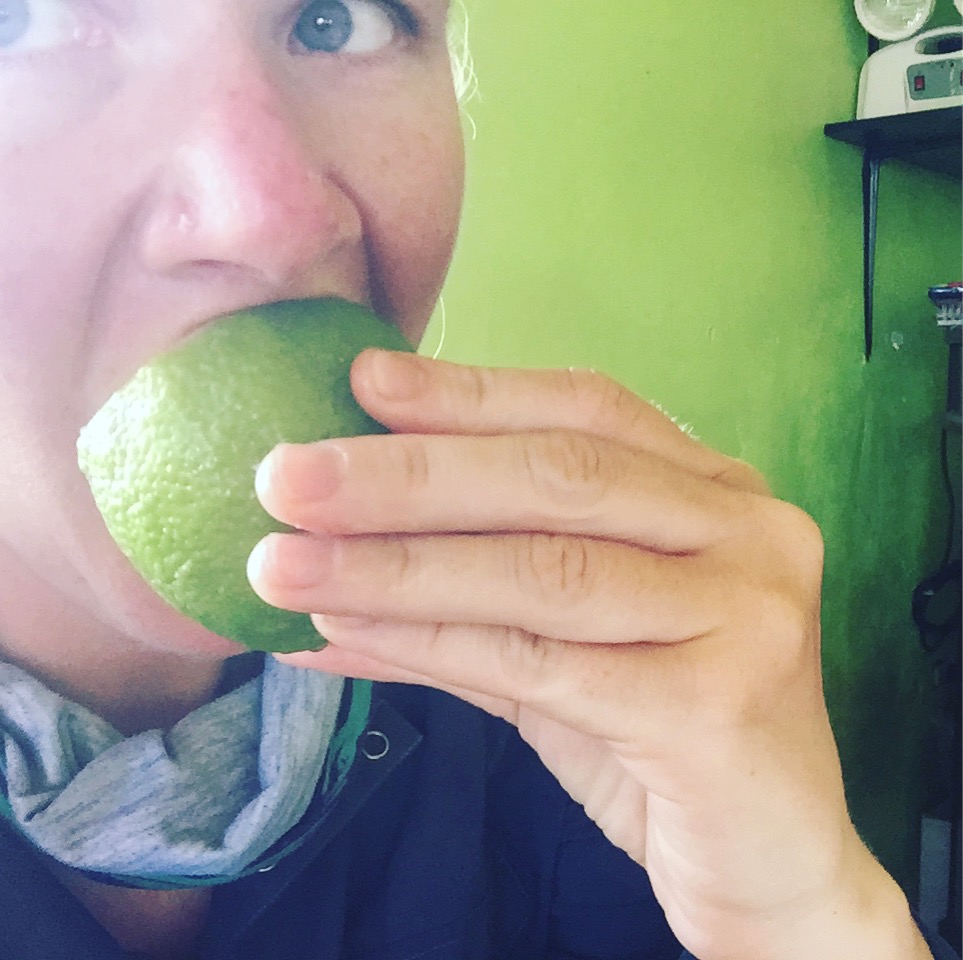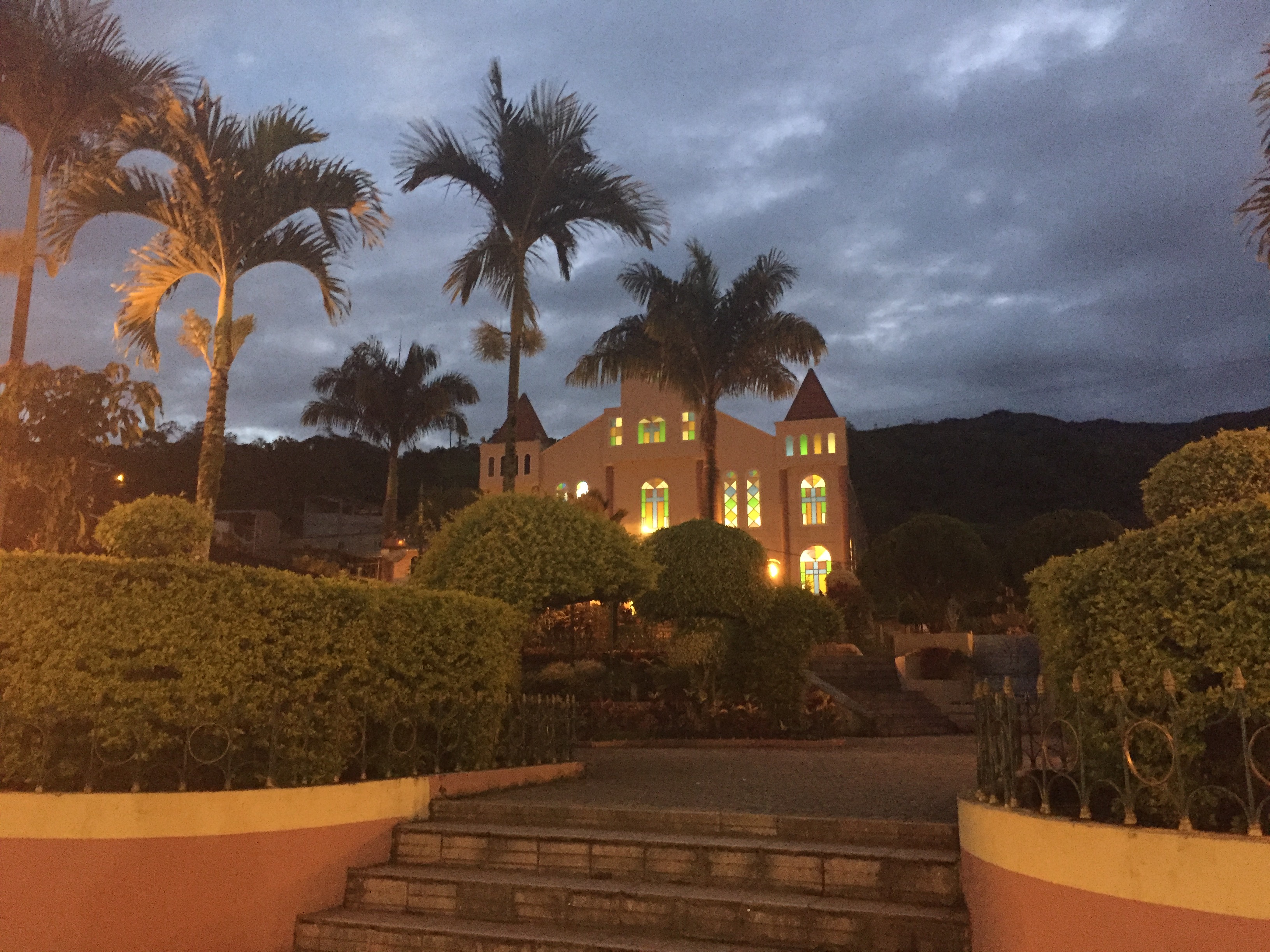Haz clic aquí para leer en español
Written by Fidgit
“I bet you thought I was going to jump,” she said.
I first saw Maria crouched in the middle of a high bridge, leaning on a stock of sugar cane, peering through the trestles at the river roaring below.
The bridge was one of those metal affairs with panels which moved and clicked as cars drove over. It was 6 pm and the lowest elevation point in a 40 km day with 4 km on into town. Evening had settled and I was pushing along with the momentum of the downhill, my will waning as I looked to the uphill into Palanda.
I looked to see what she was looking at but as two trucks came to the bridge she stood hurriedly and walked on, a bit ahead of me. The trucks clunked over the metal panels, I felt the entire bridge tremble as they passed, inches from me. Something I am well used to at this point.
We walked along the bottoms, past the hand painted sign marking the Barrio. “They wouldn’t let us into their wagon circle, so we made our own.” “They wouldn’t give us a neighborhood sign, so we made our own.” I assumed she must live down here so I was surprised when she walked past the last little house.

We fell into pace at opposite sides of the road, lost in our own worlds for a bit, I, quoting dumb movies in my head and contemplating the color of the dirt. Eventually I chalked up the nerve to ask, “what were you looking at from the bridge?”
“Just the water flowing past. It is really beautiful and quite high.” I was delighted to meet someone who stopped to enjoy beauty. It is not something I often notice locals doing. It also reminded me to do as much.
We walked on, quiet for a bit. Then, randomly, she began to talk:
“The Doctor told me I need to walk 30 minutes a day, every day. I have to keep going, for my children.”
“Have you been walking every day?”
“No,” she laughed, “But today after working I told everyone else to go on, that I preferred to walk. They probably think I have to take a dump. I was just looking at the river but then the people in those trucks were staring at me so I started to walk.”
“That was when I saw you, on the bridge. I was not sure what you were looking at.”
“I bet you thought I was going to jump,” she coughed a macabre laugh. This was a woman used to a harsh reality and facing it alone.
It was uncomfortable but I chose to let that hang and settle between us. Fortunately, at this point, I am pretty used to being uncomfortable. I see great value in it.
So, we had both considered throwing ourselves off bridges at some point.
Instead here we were, walking.

She became reflective, “My husband died five years ago. I have to keep going, for my children. So last week the Doctor told me I have to walk 30 minutes each day.” It felt like she was repeating it to convince herself. Again I fought the urge to comfort, and instead, simply received.
She brightened, “When I started to walk, I had a headache but now that I have walked it is going away.”
“That is wonderful! But you also need to drink,” I offered her my half strength Gatorade, she drank as we ambled along.
I told her a bit of my story, of being medicated through much of my youth, some in the name of depression.
“For depression you need to eat a sweet lime each day, it will help.” As she described the fruit I realized it was one the sugar cane woman had given us each a week ago. It was a delicious fruit.

“There are so many remedies and herbs in the mountains, I don’t even know them all,” she said and reached just off the side of the road, coming back with a handful of small purple berries, “these are good to chew on, they help your stomach.” We munched them as the sun set and the clouds were cast in pink.
She picked a 4 leaf purple flower from the roadside, “these are also good to eat, but only the buds,” I popped one in my mouth as she watched me. Sheesh was it tart! I puckered up and she smiled, “yeah, I think they are tart too.”
“What are they called?” I inquired.
“I don’t know, I only know them by sight,” she replied.
“Well, I suppose if I had the choice between recognizing something or knowing its name, it would be more useful to recognize it.” What is in a name, after all?
A moto came puttering down the hill toward us, she smiled, “See, I told you they could not believe I wanted to walk.” He circled and she shouted, “go back silly, I said I wanted to walk, I’m fine.” He laughed and shook his head, shouted something back then buzzed away.
“How many children do you have?”
“There are five of them,” she listed their names, “the 3 older ones are in night school, the two younger are in day school.”
Night school is a common educational alternative for children in secondary school in several of the countries we have walked through. It enables them to work and to complete their education, an option many of their parents did not have.
“My boys said that at school some girls were calling them bastards because they don’t have a father. I told them not to listen to those girls, that they are a team. That they have to stick together. They were raised like a hen’s chicks, always together. They need to stick together.”
“My mother died when I was 11, so my sister and I had to grow up and become mothers for our siblings. We worked and bought them clothes. We didn’t buy clothes for our father but we took care of the other kids. My brother did not complete school past the age of 12 but now he is a well known artist.”
A small, elderly gentleman had fallen into pace with us, “an artist you say? What is your brother’s name?”
They got to chatting in colloquial Spanish, so varied between countries, trying to adjust is a matter of eavesdropping on conversations just such as this.
“Do you think your children will graduate?”
“Next year my 3 oldest will.”
“Then they will come out further ahead than you did in school, you have propelled your children ahead of you, even alone! That is amazing. Do you think your husband would be proud of you?”
“Oh yes, I have sacrificed and worked my whole life for our children.”
We entered the outskirts of town and a little girl ran up, “this is my youngest,” the girl curled under her mother’s far arm and watched me, then skirted around her and walked in between us as we strode into town, 3 strong and with a confident gait.
For some reason, I was holding back tears.
I felt honored to share these ranks. She played with the sugar cane in her mother’s hand then traded it for the last of the Gatorade.
We reviewed the body parts in English and talked about what an 11 year old learns in school. As we arrived to the town square, she stopped and we all said goodbye in the middle of the street.

I hurried to our hotel room to scribble it all down. This post and all of our other web presences are possible because of you.
We have been particularly empowered by your support on Patreon to share the journey like this. For example, because of you we are able to afford chips for our phones and to keep them charged up so we can stay in touch from the field. We have benefited greatly from individual gifts coming in from a few consistent, Silent Givers aimed specifically at allowing us access to stay in places with internet in the exponentially more frequent towns of northern South America.
I write Maria’s parts of the story in quotes when actually they are paraphrases. These are the kinds of exchanges which I do not know how to make flow on a camera, nor roll true on a recorder. So what I offer is as close as I could understand and recall. I choose to do so, despite my shame of doing so imperfectly because,
Maria is a mighty woman.
A little mother too soon, a widow too soon, out for a walk and at just the moment to propel me up a hill without our even noticing.
Aged beyond her years but also so fresh to a particular path in life that she refreshed my eyes and challenged me to look for the beauty in the evening air, I wonder if she knows what she started when her daughter asked, “but mom, why are you walking?” and she replied simple, “because I want to.”
Maria en el río
Traduccion por Henry Tovar
Escrito por Fidgit
“Apuesto a que creías que iba a saltar”, dijo.
La primera vez que vi a María se agachó en medio de un puente alto, apoyándose en una reserva de caña de azúcar, mirando a través de los caballetes al rugir del río.
El puente era uno de esos asuntos de metal con paneles que se movían y chasqueaba cuando pasaban los autos. Eran las 6 pm y el punto de elevación más bajo en un día de 40 km con 4 km en la ciudad. La noche se había calmado y yo estaba presionando junto con el impulso de la cuesta abajo, mi voluntad menguó mientras miraba hacia la cuesta arriba en Palanda.
Miré para ver qué estaba mirando, pero cuando dos camiones llegaron al puente se levantó apresuradamente y siguió caminando, un poco adelante de mí. Las camionetas chocaron contra los paneles de metal, sentí temblar todo el puente cuando pasaron, a centímetros de mí. Algo a lo que estoy acostumbrada en este punto.
Caminamos por los fondos, más allá del letrero pintado a mano que marca el Barrio. “No nos dejaron entrar en su círculo de carretas, así que hicimos la nuestra”. “No nos dieron una señal del vecindario, así que hicimos la nuestra”. Supuse que debía vivir aquí abajo, así que me sorprendió cuando pasó por la última casita.

Caímos en ritmo a lados opuestos del camino, perdidos en nuestros propios mundos por un rato, yo, citando películas estúpidas en mi cabeza y contemplando el color de la tierra. Eventualmente tome el valor para preguntar, “¿Qué estabas mirando desde el puente?”
“Solo el agua fluye, es realmente hermosa y bastante alta”. Estuve encantada de conocer a alguien que se detuvo para disfrutar de la belleza. No es algo que a menudo noto que hacen los locales. También me recordó que hiciera tanto.
Seguimos caminando, en silencio por un momento.
Entonces, al azar, ella comenzó a hablar:
“El doctor me dijo que necesito caminar 30 minutos al día, todos los días. Tengo que seguir adelante, para mis hijos”.
“¿Has estado caminando todos los días?”
“No”, se rió, “pero hoy, después de trabajar, les dije a todos que continuaran, que prefería caminar. Probablemente piensen que tengo que hacer un basurero. Estaba mirando el río, pero luego la gente en esos camiones me estaban mirando así que comencé a caminar “.
“Fue entonces cuando te vi, en el puente. No estaba seguro de lo que estabas mirando”.
“Apuesto a que creías que iba a saltar”, tosió una risa macabra. Esta era una mujer acostumbrada a una dura realidad y enfrentarlo solo.
Era incómodo, pero decidí dejar que eso colgara y establecerse entre nosotros. Afortunadamente, en este punto, estoy bastante acostumbrada a sentirme incómoda. Veo un gran valor en eso.
Entonces, ambos pensamos en arrojarnos de puentes en algún momento.
En cambio aquí estábamos, caminando.

Ella reflexionó: “Mi esposo murió hace cinco años. Tengo que seguir adelante, para mis hijos. Así que la semana pasada el Doctor me dijo que tenía que caminar 30 minutos cada día”. Se sentía como si ella lo estuviera repitiendo para convencerse a sí misma. Una vez más luché contra el impulso de consolarme, y en su lugar, simplemente lo recibí.
Ella se animó: “Cuando comencé a caminar, me dolía la cabeza, pero ahora que he caminado, se va”.
“¡Eso es maravilloso! Pero también necesitas beber”, le ofrecí mi media fuerza de Gatorade, ella bebió mientras caminábamos.
Le conté un poco de mi historia, de haberme medicado durante gran parte de mi juventud, algunos en nombre de la depresión.
“Para la depresión, necesitas comer una lima dulce todos los días, te ayudará”. Mientras describía la fruta, me di cuenta de que era una que la mujer de la caña de azúcar nos había dado cada una hace una semana. Fue una fruta deliciosa.

“Hay tantos remedios y hierbas en las montañas, ni siquiera los conozco a todos”. dijo y llegó justo al lado de la carretera, regresando con un puñado de pequeñas bayas moradas, “estas son buenas para masticar, ayudan a tu estómago”. Los masticamos cuando se puso el sol y las nubes se tiñeron de rosa.
Escogió una flor púrpura de 4 hojas desde el borde de la carretera, “estas también son buenas para comer, pero solo las yemas”, me metí una en la boca mientras ella me miraba. Sheesh fue tarta! Me fruncí el ceño y ella sonrió, “sí, creo que son tarta también”.
“¿Cómo se llaman?” Yo consulté.
“No sé, solo los conozco de vista”, respondió ella.
“Bueno, supongo que si tuviera que elegir entre reconocer algo o saber su nombre, sería más útil reconocerlo”. ¿Qué hay en un nombre, después de todo?
Una moto bajó corriendo por la colina hacia nosotros, sonrió, “Mira, te dije que no podían creer que yo quería caminar”. Él dio vueltas y ella gritó: “vuelve loco, dije que quería caminar, estoy bien”. Él se rió y negó con la cabeza, gritó algo y luego se alejó zumbando.
“¿Cuántos hijos tiene?”
“Hay cinco de ellos”, dijo en una lista sus nombres, “los 3 más viejos están en la escuela nocturna, los dos más jóvenes están en la escuela diurna”.
La escuela nocturna es una alternativa educativa común para los niños en la escuela secundaria en varios de los países que hemos visitado. Les permite trabajar y completar su educación, una opción que muchos de sus padres no tenían.
“Mis muchachos dijeron que en la escuela algunas chicas los llamaban bastardos porque no tenían padre. Les dije que no escucharan a esas chicas, que son un equipo. Que tienen que permanecer juntas. Se criaron como un chicas de gallina, siempre juntas. Necesitan mantenerse unidas “.
“Mi madre murió cuando yo tenía 11 años, así que mi hermana y yo tuvimos que crecer y convertirnos en madres de nuestros hermanos. Trabajamos y compramos ropa. No compramos ropa para nuestro padre pero cuidamos a los otros niños. Mi hermano no completó la escuela más allá de los 12 años, pero ahora es un artista conocido “.
Un caballero pequeño y anciano se había puesto al ritmo de nosotros, “¿un artista que dices? ¿Cuál es el nombre de tu hermano?”
Llegaron a conversar en coloquial español, tan variado entre países, tratando de adaptarse es una cuestión de aleros cayendo en conversaciones como esta.
“¿Crees que tus hijos se graduarán?”
“El año que viene mi 3 más viejo lo hará”.
“Entonces saldrán más adelante de lo que lo hiciste en la escuela, has impulsado a tus hijos por delante, ¡incluso solos! Eso es increíble. ¿Crees que tu esposo estaría orgulloso de ti?”
“Oh, sí, me sacrifiqué y trabajé toda mi vida para nuestros hijos”.
Entramos en las afueras de la ciudad y una niña corrió, “esta es mi hija menor”, la niña se acurrucó bajo el brazo de su madre y me miró, luego la rodeó y caminó entre nosotros mientras caminábamos hacia la ciudad, 3 fuertes y con una marcha segura.
Por alguna razón, estaba conteniendo las lágrimas.
Me sentí honrado de compartir estos rangos. Jugó con la caña de azúcar en la mano de su madre y luego la cambió por la última Gatorade.
Revisamos las partes del cuerpo en inglés y hablamos sobre lo que aprende un niño de 11 años en la escuela. Cuando llegamos a la plaza del pueblo, ella se detuvo y todos nos despedimos en el medio de la calle.

Corrí a nuestra habitación de hotel para garabatear todo. Esta publicación y todas nuestras otras presencias web son posibles gracias a ustedes.
Su apoyo en Patreon nos ha fortalecido especialmente para compartir el viaje de esta manera. Por ejemplo, gracias a usted podemos comprar fichas para nuestros teléfonos y mantenerlas cargadas para que podamos mantenernos en contacto desde el campo. Nos hemos beneficiado en gran medida de los obsequios individuales provenientes de unos pocos consejeros silenciosos, consistentes y consistentes en permitirnos acceder a lugares con Internet en las ciudades exponencialmente más frecuentes del norte de Sudamérica.
Escribo las partes de la historia de María entre comillas cuando en realidad son paráfrasis. Estos son los tipos de intercambios que no sé cómo hacer fluir en una cámara, ni rodar en una grabadora. Entonces, lo que ofrezco es lo más cercano que pude entender y recordar. Elijo hacerlo, a pesar de mi vergüenza de hacerlo imperfectamente porque,
María es una mujer poderosa.
Una pequeña madre demasiado pronto, una viuda demasiado pronto, a dar un paseo y en el momento justo para impulsarme colina arriba sin que siquiera lo notemos.
Envejecida más allá de sus años, pero también tan fresca en un camino particular en la vida que refrescó mis ojos y me desafió a buscar la belleza en el aire de la noche, Me pregunto si ella sabe lo que comenzó cuando su hija le preguntó: “pero mamá, ¿por qué estás caminando?” y ella respondió simple, “porque quiero”.






Comments (3)
thank you Fidgit, lovely!
At first I wished to see a photo of Maria, now realize that we know her better from your words.
Alan, this is one of the sweetest compliments I have ever received on a blog post.
Thank you so much for giving your time to getting to know her!
🙂